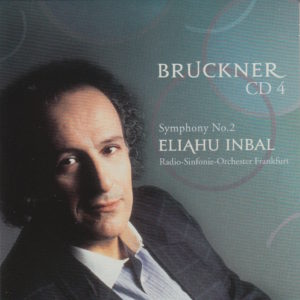 My “office” this morning is, once again, Baker Book House – where the books are plentiful, the staff is exceptional, and the coffee and home-made scones are mouth-watering.
My “office” this morning is, once again, Baker Book House – where the books are plentiful, the staff is exceptional, and the coffee and home-made scones are mouth-watering.
I could live here.
And almost have over the past couple of years.
If you live in the Midwest, you owe it to yourself to visit this towering bookstore among bookstores.
On to the task at hand…
 This morning, I am listening to Anton Bruckner’s Symphony No. 2 in C Minor (WAB 102), nicknamed “The Symphony of Pauses,” interpreted by Israeli conductor Eliahu Inbal (1936-).
This morning, I am listening to Anton Bruckner’s Symphony No. 2 in C Minor (WAB 102), nicknamed “The Symphony of Pauses,” interpreted by Israeli conductor Eliahu Inbal (1936-).
Prior to Day 3 I had never heard Maestro Inbal, which is a lot of fun for me because that means I get to research him while I listen.
His entry on Wikipedia tells me he,
…studied violin at the Israeli Academy of Music and took composition lessons with Paul Ben-Haim. Upon hearing him there, Leonard Bernstein endorsed a scholarship for Inbal to study conducting at the Conservatoire de Paris, and he also took courses with Sergiu Celibidache and Franco Ferrara in Hilversum, Netherlands. At Novara, he won first prize at the 1963 Guido Cantelli conducting competition.
Inbal has conducted a wide variety of works. He is best known for his interpretations of late-Romantic works, but is also noted as an opera conductor, and has given the premieres of a number of modern works.
Inbal’s orchestra is Radio-Sinfonie-Orchester Frankfurt, which Wikipedia tells me is,
…the radio orchestra of Hessischer Rundfunk, the public broadcasting network of the German state of Hesse. From 1929 to 1950 it was named Frankfurter Rundfunk-Symphonie-Orchester. From 1950 to 1971 the orchestra was named Sinfonie-Orchester des Hessischen Rundfunks, from then to 2005 Radio-Sinfonie-Orchester Frankfurt. For a long time the English translation Frankfurt Radio Symphony Orchestra was used for international tours, since 2015 the official international name is Frankfurt Radio Symphony.
The orchestra’s range of musical styles includes the classical-romantic repertoire, discoveries in experimental new music, concerts for children and young people and demanding programming concepts.
I’m going to refer to Radio-Sinfonie-Orchester Frankfurt by its new name – Frankfurt Radio Symphony – from now on, mmm kay?
As I mentioned on Day 3 (and won’t mention again after this), sharp minds among you may have noticed that my list of conductors looks like this:
Daniel Barenboim with the Berlinker Philarhmoniker
Daniel Barenboim with Staatskapelle Berlin
Sergiu Celibidache
Wilhelm Furtwangler
Eliahu Inbal
Marek Janowski
Otto Klemperer
Simone Young
So why am I listening to Eliahu Inbal instead of Sergiu Celibidache and Wilhelm Furtwangler, both of whom would follow Barenboim alphabetically?
Because the CD box sets by Celibidache and Furtwangler don’t include Bruckner’s Symphony No. 1. So I had to skip over them. The next name in line is Inbal.
Mystery solved.
Here are the objective stats about today’s performance:
 Bruckner’s Symphony No. 2 in C Minor (WAB 102), composed 1872
Bruckner’s Symphony No. 2 in C Minor (WAB 102), composed 1872
Eliahu Inbal conducts
Inbal used the “Revised version, 1877” according to the liner notes
Radio-Sinfonie-Orchester Frankfurt plays
The symphony clocks in at 61:48
This was recorded in Frankfurt, Germany, in June of 1988
Inbal was 52 when he conducted it
Bruckner was 48 when he finished composing it (the first time)
This recording was released on the Warner Classics & Jazz label/Teldec Classics label
Bruckner wrote his symphonies in four movements. The time breakdown of this one (Symphony No. 2 in C Minor), from this particular conductor (Inbal) and this particular orchestra (Frankfurt Radio Symphony) is as follows:
I. Moderato……………………………………………………………………………………………………..20:08
II. Andante: Feierlich, etwas bewegt (Solemnly, somewhat animated)…………16:30
III. Scherzo: Mäßig schnell (Moderately fast)……………………………………………………7:17
IV. Finale: Ziemlich schnell (Fairly fast)……………………………………………………………17:51
The score calls for a pair each of flutes, oboes, clarinets, bassoons, four horns, two trumpets, three trombones, timpani, and strings.
Total running time: 61:48
The 1877 version, according to its entry on Wikipedia,
1877 version
The editions by Robert Haas (published 1938) and Leopold Nowak (published 1965) are both based on this version.
Haas’ edition contains some features of the previous version, which, as in the 1890 version of the 8th symphony, were crossed out by Bruckner in the 1877 manuscript. The edition by William Carragan (published 1997) is a corrected Nowak edition. Most recordings of the symphony are made of the Haas and Nowak versions. The Carragan edition has been recorded by Daniel Barenboim.
Okay. Now, here are the subjective aspects:
My Rating:
Recording quality: 4
Overall musicianship: 4
CD liner notes: 3 (very thin booklet, sparse essay about Bruckner translated into English, German, and French; no information at all about Eliahu Inbal)
How does this make me feel: 4
I think my cat Larry could record Bruckner’s Second and I’d love it. That’s because I love Bruckner’s Second.
The Andante to B2 is one of the most beautifully written pieces of music I’ve ever heard. Especially in the parts I always mention: horn and strings, playing pizzicato.
I always drink that in, enjoy every swallow.
It starts around the 2:44-3:19 mark, then repeats at 8:05-8:40. Then, that beautiful melody is played by what sounds like the entire orchestra at 9:08-9:38. It’s a powerful piece of music, that Andante. It even ends ever-so-delicately, slowly, gently.
Love it.
The Inbal CD box set is turning out to be a solid one so far. But the lack of decent liner notes mars it considerably in my opinion.
As for the quality of the recordings, I think they’re very fine.
The last minute of the Finale, with timpani rolling and orchestra building is an exciting piece of music.
But my favorite movements in Bruckner’s Second are the first (Moderato) and second (Andante). The Scherzo of B2 isn’t as exciting to me as it usually is in a Bruckner symphony. So Inbal doesn’t really add much to be enjoyment in this performance. It’s okay. Just not kick-in-the-ass stirring.
